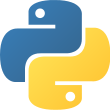 Language
Language
- Python 3
 Reading time
Reading time
- Approximately 16 days
 What you will learn
What you will learn
- Numerical Programming and Data Mining
- Graphics and Computer Vision
 Author
Author
- Jesse M. Kinder
 Published
Published
- 7 years, 7 months ago
 Packages you will be introduced to
Packages you will be introduced to
- numpy
- scipy
- matplotlib
- sympy
A fully updated tutorial on the basics of the Python programming language for science students
Python is a computer programming language that is rapidly gaining popularity throughout the sciences. This fully updated edition of A Student's Guide to Python for Physical Modeling aims to help you, the student, teach yourself enough of the Python programming language to get started with physical modeling. You will learn how to install an open-source Python programming environment and use it to accomplish many common scientific computing tasks: importing, exporting, and visualizing data; numerical analysis; and simulation. No prior programming experience is assumed.
This tutorial focuses on fundamentals and introduces a wide range of useful techniques, including:
- Basic Python programming and scripting
- Numerical arrays
- Two- and three-dimensional graphics
- Monte Carlo simulations
- Numerical methods, including solving ordinary differential equations
- Image processing
- Animation
- Professor at The Oregon Institute of Technology
